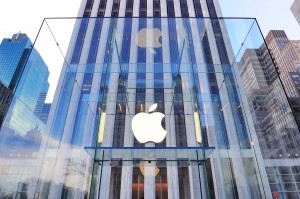Apple Inc. (NASDAQ:AAPL) raised many questions with its decision to carry out a 7-for-1 stock split this June, a plan announced during the conference call following the company’s Q2 2014 earnings report. The mechanics of the split are clear enough. On that date, each shareholder of record will receive 6 additional shares in Apple for each share they currently own. Simultaneously, the price of each share will be cut to 1/7th of the pre-split price. However, analysts and market watchers continue to be puzzled by Apple’s decision.
One of the most obvious effects of the split is also least likely to be a prime motivator in the Board of Directors’ decision – the split opens to the door to inclusion in the Dow Jones Industrial Average (INDU). As Bloomberg reported, the powerful Cupertino firm has not been included in the exclusive circle of 30 major industrial stocks because its current stock price, consistently trading above $500 per share, would skew its influence too high relative to the other INDU members. However, with share prices dropped below $100 per share – likely in the neighborhood of $75 – it would suddenly be eligible for inclusion in the Dow 30.
 Though the 7-for-1 split is likely to place Apple Inc. (AAPL) on the Dow Jones Industrial Average, somewhere in the lower middle range of companies, this would probably not offer the company too many advantages it does not already have. Inclusion in the Dow 30 would be a symbolic victory, but offers too few tangible benefits for this to be the firm’s likely motivator.
Though the 7-for-1 split is likely to place Apple Inc. (AAPL) on the Dow Jones Industrial Average, somewhere in the lower middle range of companies, this would probably not offer the company too many advantages it does not already have. Inclusion in the Dow 30 would be a symbolic victory, but offers too few tangible benefits for this to be the firm’s likely motivator.
Analyst Timothy Worstall of Forbes Magazine offers a different possibility, based on the theorizing of Bloomberg’s Mark Levine. Traders prefer to deal in standard lot sizes of 100 shares or more, rather than buying and selling individual shares. At, say, $530 per share, this means the smallest practical trade of Apple shares is worth at least $53,000, pricing even most mid-range investors out of the game. However, much greater granularity is introduced, and reasonably sized transactions become possible, when the minimum transaction is 1/7 as much, or around $7,600.
If Mr. Worstall’s idea is correct, then the 7-for-1 split will greatly increase the liquidity of Apple’s shares – by around sevenfold, in fact. This will enable smaller players to participate more actively and encourage a more dynamic market that might eventually bid Apple’s shares up closer to their estimated value of $600 to $700. Such a change would provide obvious benefits to the firm and could be a strong motivator.
A third plausible explanation is that Apple Inc. (AAPL) is carrying out the split as a public relations move, and both the greater ease of transactions in 100-share blocks, and inclusion on the Dow, are simply extra benefits that the Cupertino firm is happy to reap at the same time. Shareholder trust is a major asset for any firm. Since investors have been calling for a stock split for years, the latest move by Apple Inc. (AAPL) may be calculated mainly to show that despite being secretive, it is indeed responsive to its shareholders’ wants and needs. Greater liquidity and Dow Jones membership, in this case, would simply be superb fringe benefits accruing to what is essentially a large-scale PR move.



